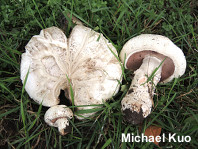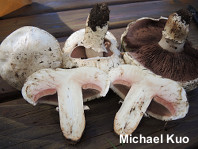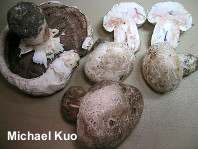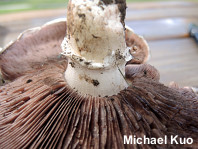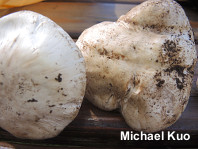| Major Groups > Gilled Mushrooms > Dark-Spored > Agaricus > Agaricus bernardi |

|
Agaricus bernardi [ Basidiomycota > Agaricales > Agaricaceae > Agaricus . . . ] by Michael Kuo Originally described from seaside dunes in France, Agaricus bernardi has since been found in other maritime ecosystems in Europe, on the Pacific and Atlantic coasts of our continent, and in grassy areas in Pennsylvania and Colorado. In inland settings it is often—but not always—found in places near roads that regularly receive salt treatment for ice in wintertime.
Agaricus bernardi is a tough-stemmed, fairly large species that features red-staining flesh, an inrolled cap margin, and a ring that sheathes the stem and flares outward at its apex. Agaricus bitorquis is a similar species, but its red staining, if it occurs at all, is faint (and it prefers hard-packed soil in urban areas and features 2-spored basidia). Agaricus bernardiformis is also similar, but it is known in North America from only one collection (near Denver); it features crumbling-granular veil remnants on the cap, and does not stain red. Description: Ecology: Saprobic; growing alone, scattered, or gregariously in sand dunes and drainage areas near coastal and brackish waters; also in lawns and grassy areas along roadsides, especially where roads are salted for ice in the winter; summer and fall, or over winter in warm climates; precise North American distribution uncertain, but well documented in California, Colorado, and Pennsylvania. The illustrated and described collections are from Colorado. Cap: 5–15 cm; convex, becoming broadly convex; white and fairly bald when young, becoming cracked or subscaly and sometimes developing brownish or brown colors; dry; the margin strongly inrolled. Gills: Free from the stem; close or crowded; short-gills frequent; pink at first, becoming brown and then dark chocolate brown in maturity; covered with a white partial veil when in the button stage. Stem: 5–9 cm long; 2.5–3.5 cm thick; more or less equal, or tapering to base when mature; bald or finely roughened; with a sheathing white ring that flares outward on its upper edge; solid and very firm; whitish to brownish, bruising reddish. Flesh: Whitish; changing to pinkish or reddish when sliced; not yellowing, even in the base of the stem. Odor: Unpleasant; reminiscent of brine. Chemical Reactions: KOH negative on cap surface. Spore Print: Dark brown. Microscopic Features: Spores: 6–8 x 5–6 µm; broadly ellipsoid; smooth; thick-walled; brown in KOH, with a pale, contrasting apiculus. Basidia 4-sterigmate. Cheilocystidia 30–50 x 5–10 µm; cylindric-flexuous to clavate, capitate, or a bit irregularly swollen toward the apex; septate; smooth; thick-walled; yellowish to brown in KOH. Pleurocystidia not found. Pileipellis a poorly defined cutis; elements 2.5–10 µm wide, smooth, hyaline to yellowish in KOH. REFERENCES: Quélet, 1878. (Saccardo, 1887; Phillips, 1981; Arora, 1986; Kerrigan, 1986; Hansen & Knudsen, 1992; Nauta, 2001; Challen, Kerrigan & Callac, 2003; Didukh et al., 2005; Geml et al., 2008; Knudsen, Lange & Knutsson, 2008; Desjardin, Wood & Stevens, 2015; Evenson, 2015; Siegel & Schwarz, 2016; Cripps, Evenson & Kuo, 2016; Kerrigan, 2016.) Herb. Kuo 08111501. This site contains no information about the edibility or toxicity of mushrooms. |
© MushroomExpert.Com |
|
Cite this page as: Kuo, M. (2017, December). Agaricus bernardi. Retrieved from the MushroomExpert.Com Web site: http://www.mushroomexpert.com/agaricus_bernardi.html |
